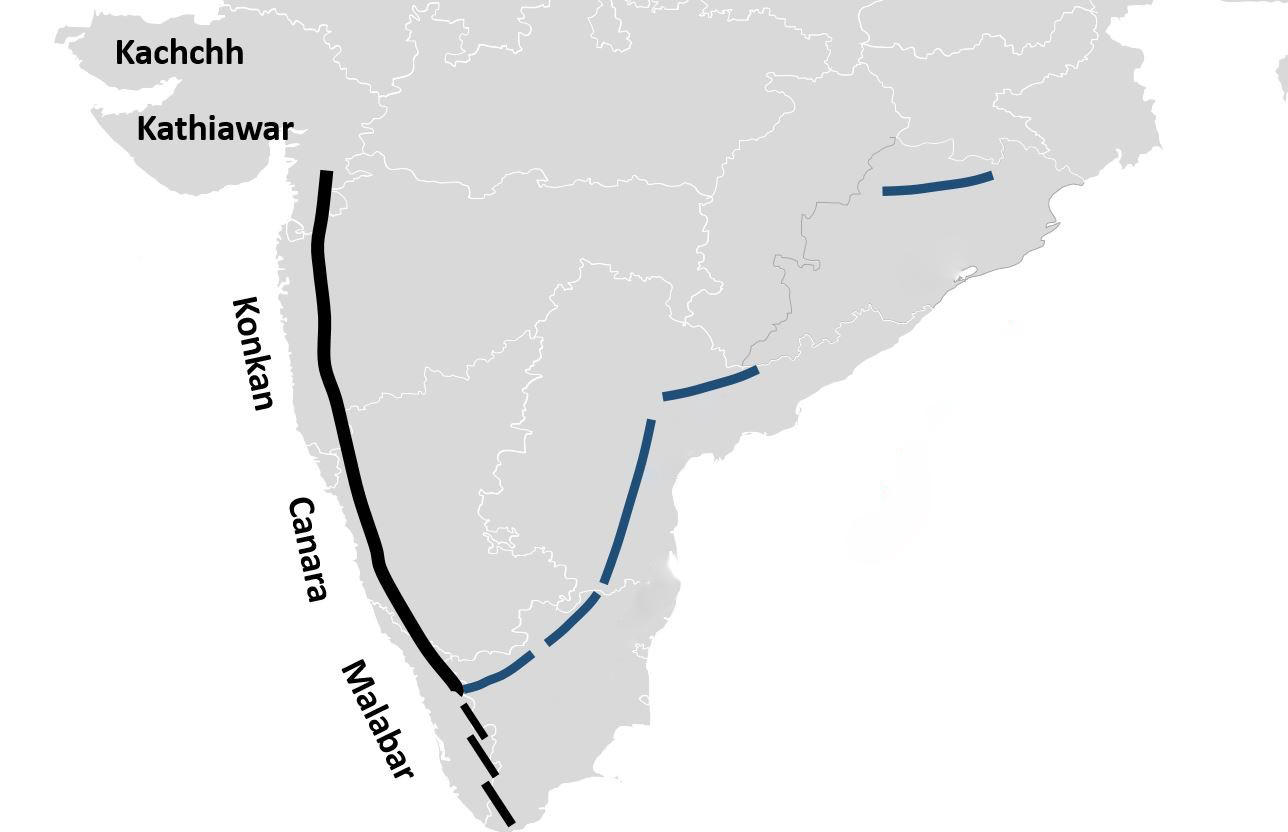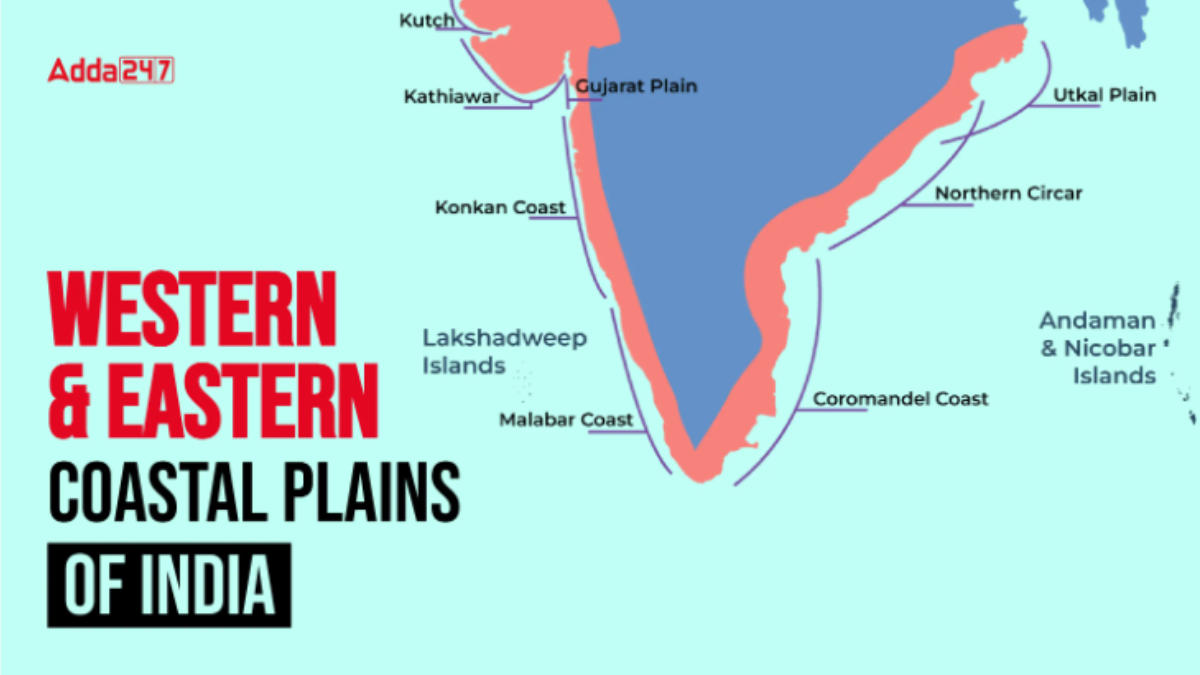Table of Contents
Coastal plains are a crucial topic of geography in UPSC preparation. In today’s article, we will discuss about The Coastal Plains of India (the western and eastern coastal plains) in detail. It includes the features of coastal plains, geographical location, and the difference between them. The Coastal Plains of India is not only important from the exam point of view but is also essential to understanding the geographical structure of India. In this article, all the important information related to coastal plains has been presented in a simple and concise form, so that you can understand and remember it easily.
What is The Coastal Plains?
It’s important to define a coastal plain before delving into the details of India’s coastal plains. Low-lying, level terrain next to the ocean is known as the coastal plain. Usually, surrounding landforms like mountains keep them isolated from the interior. These plains, which can stretch inland for variable lengths from the shoreline, are created by the deposition of sediments from rivers and streams as they flow into the sea
Indian Geography Notes for UPSC
Coastal Plains of India Map
Using a map is extremely helpful in understanding the Southern Coastal Plains of India. However, it can be explained without a map as well. The coastal plains of India are divided into two main parts: the Western Coastal Plains and the Eastern Coastal Plains.
Western Coastal Plains
- Kutch Coast: It starts from the Kutch region of Gujarat.
- Kathiawar Coast: Moving south from Kutch, this coast extends to Kathiawar.
- Konkan Coast: Covers the region from Mumbai to Goa.
- Goa Coast: Covers the Goa region.
- Malabar Coast: Starting from Karnataka and extends to Kanyakumari in Kerala.

Eastern Coastal Plains
- Utkal Coast: It starts from the region of Odisha.
- Andhra Coast: Moving south from Odisha, this coast extends to Andhra Pradesh.
- Coromandel Coast: Covers the coastal region of Tamil Nadu and extends to the southern part of Andhra Pradesh.

Coastal Plains of India
India is a peninsular country which means it is surrounded by land on three sides. The main coastal plains in India extend to 7516.6 km in the west and east, India’s coastline touches 13 states and union territories. There are two types of coastal plains in India:
- The Western Coastal Plains of India
- The Eastern Coastal Plains of India
Western Coastal Plains of India
The Western Coastal Plain is located in many major cities of India such as it is spread from Gujarat, Karnataka, Goa and Maharashtra in the north to Kerala in the south. The Western Coastal Plain is spread from Rann of Kutch (Gujarat) in the north to Kanyakumari (Kerala) in the south. The length of the Western Coastal Plain extends from north to south to 1500 kilometers and its width is from 10 to 25 kilometers. Parts of the western coastal plain are divided into different regions, such as Kutch and Kathiawar coast in Gujarat, Konkan coast in Maharashtra, Goan coast and Malabar coast in Karnataka and Kerala respectively.
Kachchh and Kathiawar coast in Gujarat
The coasts of Kachchh and Kathiawar were shaped by the sediment deposits carried by the Indus River. During the monsoon season, Kachchh transforms into a region partly submerged under shallow water. It’s divided into the Great Rann to the north and the Little Rann to the east.
Konkan coast in Maharashtra
The Konkan coast stretches from Daman in the north to Goa in the south. This region is known for its cultivation of rice and cashew, which are the primary agricultural crops grown here.
Goan coast in Karnataka
The Kannada coast, extending from Marmagaon to Mangalore, spans a significant stretch along the western coastline of India. It is approximately 225km long.
Malabar coast in Karnataka and Kerala
The Malabar Coast, stretching from Mangalore to Kanyakumari, is relatively broad. This region includes parallel lagoons along the coastline of southern Kerala. It spans approximately 500 kilometers between Mangalore and Kanyakumari.
Eastern Coastal Plains of India
The Eastern Coastal Plain passes through Andhra Pradesh and Odisha on its way from West Bengal in the north to Tamil Nadu in the south. This enormous region includes the deltas of important rivers such as the Godavari, Krishna, Mahanadi, and Kaveri. The Utkal coast in Odisha, the Andhra coast in Andhra Pradesh, and the Coromandel coast in Tamil Nadu are some of the regions that make up the Eastern Coastal Plain.
Utkal Coast in Odisha
The Utkal Plain covers the coastal region of Odisha, including the vast Mahanadi delta. The region is also home to the famous Chilika Lake.
Andhra coast in Andhra Pradesh
The Andhra Plain lies south of the Utkal Plain and stretches along the Andhra coast between Kolleru Lake and Pulicat Lake. It forms a basin area for the Krishna and Godavari rivers.
Coromandel coast in Tamil Nadu
The Coromandel Coast stretches for a distance of about 675 km between Pulicat Lake and Kanyakumari in Tamil Nadu. The most important feature of this plain is the Cauvery Delta where the plain is 130 km wide.
Significance of Coastal Plains of India
The importance of India’s coastal plains lies in several aspects. These regions are not only the hubs of trade and commerce but also hold a variety of economic and environmental significance. Taking together all these points, it is clear that the coastal plains of India are not only economically important but are also extremely important from environmental and social points of view. Let’s take a look at the various aspects of these regions:
Trade and Employment
- Ports and Trade: There are several major and minor ports located along the Indian coastlines, which are the main hubs of trade. These ports not only promote international trade but also provide employment opportunities to the locals.
- Fishing: Fishing is an important occupation in coastal areas. It is not only a major source of employment for the locals but also plays a vital role in India’s food security.
Agriculture and Land Fertility
- Fertile Land: The land in the coastal plains is extremely fertile, making them ideal for farming. The fertile land here is suitable for cultivating a variety of crops.
Environment and Ecosystem
- Rich Ecosystem: A variety of ecosystems are found in the coastal plains, including mangroves, coral reefs, estuaries, and lagoons. These ecosystems play an important role in preserving biodiversity.
- Mineral Resources: Mineral resources such as salt, monazite, mineral oil and gas are found in coastal areas. These areas are also likely to have large reserves of mineral oil, which can be important in meeting the energy needs of the country.
Community Life
- Marine Life: The lives of communities living in coastal areas depend mainly on the sea. Occupations such as fishing, seaweed collection and tourism are an integral part of their lives.
Difference Between Eastern and Western Coastal Plains
| Feature | Western Coastal Plains | Eastern Coastal Plains |
|---|---|---|
| Geographical Extent | Stretching from Gujarat to Kerala along the Arabian Sea | Extends from Odisha to Tamil Nadu along the Bay of Bengal |
| Topography | Narrower compared to the Eastern Coastal Plains | Wider compared to the Western Coastal Plains |
| Water Bodies | Rivers form estuaries along this coast | Rivers form wide deltas in this region |
| Rainfall | Receives a high amount of rain predominantly from the southwest monsoons | Receives rains from both northeast and southwest monsoons |
| Terrain Features | Intersected by mountain ridges | Generally a level surface, conducive to agriculture except for the Malabar Coast |



 TSPSC Group 1 Question Paper 2024, Downl...
TSPSC Group 1 Question Paper 2024, Downl...
 TSPSC Group 1 Answer key 2024 Out, Downl...
TSPSC Group 1 Answer key 2024 Out, Downl...
 UPSC Prelims 2024 Question Paper, Downlo...
UPSC Prelims 2024 Question Paper, Downlo...




